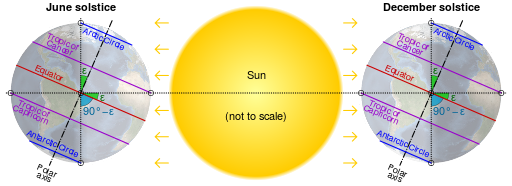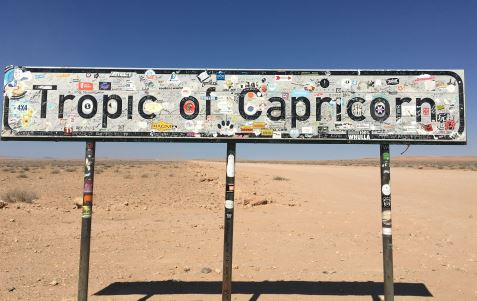Half an hour after leaving Solitaire, we reached the Tropic of Capricorn precisely located at 23°26′11.1″ south of the Equator. The Tropic of Capricorn runs through Africa, Australia, and South America. Also called the Southern Tropic, it is described as "the circle of latitude that contains the subsolar point at the December (or southern) Solstice. It is thus the southernmost latitude where the sun can be seen directly overhead. It also reaches 90 degrees below the horizon at solar midnight on the June Solstice."
Its northern equivalent is the Tropic of Cancer that passes through several countries in North Africa, the Middle East, Asia, the gulf of California, Mexico, and the Bahamas.
We passed by two huge markers on both sides of the road and stopped for a photo op. One of the signs was clean-cut, while the other was festooned with stickers. Apparently, it is tradition for travelers to place a sticker there or affix their signatures. We chose the clean-cut one for our picture.
Since there was not much to do there, we left shortly to drive to our next destination, another canyon.
Kuiseb Canyon is spectacular canyon carved by the Kuiseb River, which flows from the Khomas highlands west of Windhoek to Walvis Bay millions of years ago. This river floods the canyons during days of heavy rains, but it only gets as far as Gobabeb before seeping into the sand. It seldom flows on the surface and even more seldom does it reach the sea, but it plays a very important role in preventing the northward march of the sand dunes closer to the coast. Once the river dries up, open water can still be found in its pools.
We took the C14 gravel road and I must say we all admired and appreciated our guide’s driving skills. He made navigating this challenging road seem like a regular leisure drive.
When we reached Gambsberg Pass, we made a short stop. From the top of this pass, we took pictures of the spectacular views of the dry Kuiseb River bed and the valleys below. I tried to imagine how this water course would have looked under heavy rains, raging torrentially as water snakes its way into the valley. At that moment though, everything looked parched. The barren and rocky landscape looked desolate with no sign of life, apart from a cluster of trees and few zebras grazing on what was left of the grass.
We did see a dead snake on the road. It was huge and it seemed like it had just died a few hours ago, probably from thirst, as there were no signs of it being run over by another vehicle. It had no visible injuries either. The scales were still intact and the flesh still plump and tender. For a moment, we doubted ourselves and feared it was somehow faking its death. It could be a trap for us and maybe, it would spring to life anytime and bite us. But our guide, who is a wildlife expert, kicked it gently and assured us it was quite harmless at that point. I quickly took a shot and walked back to the van.
We proceeded to the Kuiseb Pass. Again, our guide’s driving skills amazed us. This mountain pass, at an elevation of 905 meters above sea level, is one of the highest roads in the country. It is mostly gravel and tar with some steep sections that made us hold our breaths.
Our guide said that the speed limit there is 70 kilometers per hour and that though driving during the dry season is not as dangerous compared to that of the rainy season, one must pay attention because if you run off-course, there is a considerable drop down below. He also let us in on a little secret, though we doubted if it would be useful to us since we do not intend to drive there on our own. He said that one must ensure that the tire pressure is down to about 1.7 bar. The combination of high tire pressure and the road conditions there is a recipe for an accident. We drove all the way to the summit without any incidents for another scenic stop. I reminded myself that indeed, there are times when you put your life in the hands of your driver.
The Kuiseb Canyon offers unique scenery. Its southern bank is formed by massive red sand dunes, and the northern bank by pitch black rock formations, while the riverbed itself is overgrown by massive endemic trees. The dry sand bed creates a kaleidoscope of green and white tones.
Our guide shared a little piece of history with us, and this one was interesting for our German travel mates. It was in this very canyon where the famous German geologists, Henno Martin and Hermann Korn went into hiding for more than two years during the Second World War to escape imprisonment. In his book, The Sheltering Desert, Henno recounts the amazing story of their survival. Our guide added that if you hike the canyon, you can even visit the ruins of their shelter. Our German companions mentioned that there was also a movie made about them, but they couldn’t remember the title as they have not seen it.
Photo Credits:
dangerousroads.com, Chtrede (Wikipedia), atlasobscura.com, dpreezg, AndreasW0205, orkeyinga, angelo.edu, mapio.net, tracks4africa.com.za (Janine Reyneke)














































Comentarios